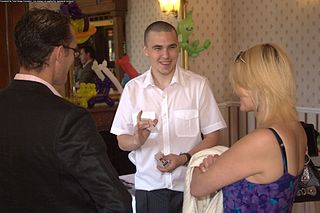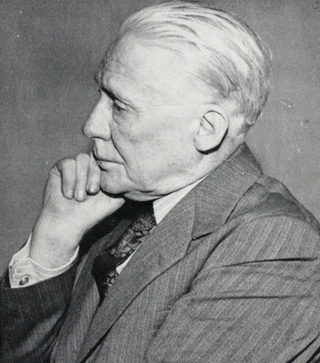
Card manipulation is the branch of magic that deals with creating effects using sleight of hand techniques involving playing cards. Card manipulation is often used in magical performances, especially in close-up, parlor, and street magic. Some of the most recognized names in this field include Dai Vernon, Tony Slydini, Ed Marlo, S.W. Erdnase, Richard Turner, John Scarne, and Ricky Jay. Before becoming world-famous for his escapes, Houdini billed himself as "The King of Cards". Among the more well-known card tricks relying on card manipulation are Ambitious Card, and Three-card Monte, a common street hustle also known as Find the Lady.
A trick deck is a deck of playing cards that has been altered in some way to allow magicians to perform certain card tricks where sleight of hand would be too difficult or impractical.
The Ambitious Card, or Elevator Card, is a magic effect in which a playing card seems to return to the top of the deck after being placed elsewhere in the middle of the deck. This is a classic effect in card magic and serves as a study subject for students of magic. Most performing card magicians will have developed their own personal Ambitious Card routine.

Cardistry is the performance art of card flourishing. Unlike card magic, cardistry is meant to be visually impressive and appear very hard to execute.

David Frederick Wingfield Verner, better known by his stage names Dai Vernon or The Professor, was a Canadian magician.
A double lift is a sleight of hand maneuver used by magicians in card magic. It is a method by which the identity of the top card may be kept secret by lifting the top two cards as one, making it seem as if only the top card is picked up. Similar techniques may be applied to more than two cards to perform a triple or even quadruple lift. The term was coined by Theo Annemann.
This is a glossary of conjuring terms used by magicians.
Spelling Bee may refer to one of several card tricks that revolve around the spelling of card types, audience member names, or words suggested by the audience. Many make use of decks prepared in advance in order to provide the illusion of spelling card names in a particular sequence. Jean Hugard's Encyclopedia of Card Tricks lists a number of such spelling-based tricks, many of which are considered to be self-working.
The Circus Card Trick is a self-working card trick where the performer uses verbal misdirection to prompt the participant into betting that the performer has failed to execute the trick correctly. The performer exploits the ambiguous wording of their patter to win the bet in a manner unexpected by the audience. It is often recommended for beginning magicians due to its entertaining and self-working nature.

The hat-trick is a classic magic trick where a performer will produce an object out of an apparently empty top hat.

The Expert at the Card Table, is an extensive book on the art of sleight of hand published in 1902 by S. W. Erdnase, a pseudonymous author whose identity has remained a mystery for over a century. As a detailed manual of card sharps, the book is considered to be one of the most influential works on magic or conjuring with cards.

Close-up magic is magic performed in an intimate setting usually no more than 3 meters from one's audience and is usually performed while sitting at a table.
Platform magic is magic that is done for larger audiences than close-up magic and for smaller audiences than stage magic. It is more intimate than stage magic because it does not require expensive, large-scale stage equipment and can thus be performed closer to the audience and without a stage. Many of the tricks performed by platform magicians are sufficiently angle-sensitive as to make them impossible to perform as micromagic. Most working magicians are parlor/platform magicians.

Chink-a-chink is a simple close-up magic coin trick in which a variety of small objects, usually four, appear to magically transport themselves from location to location when covered by the performer's hands, until the items end up gathered together in the same place. Variations, especially the Sympathetic Coins also known as Coins-n-Cards, have been performed since the 1800s. Popular modern variations are Shadow Coins and Matrix. A variation using playing cards as the objects is known as Sympathetic Aces.

Jean Hugard was an Australian professional magician.
Frederick Braue[pronounced BROW-ee] was an American journalist notable for his contribution to the field of card magic. He was a semi-professional magician, specializing in card magic, of which he was a master.
Francis Carlyle was a professional magician who was a regular and popular performer at Hollywood's Magic Castle.
Daniel and David Buck are American sleight of hand practitioners known for their contributions to the art of cardistry.

The art form of card flourishing, commonly referred to as cardistry, grew out of simple flourishes used in close-up magic by magicians in the 1990s to early 2000s. Chris Kenner's notable two-handed Sybil cut from his 1992 publication Totally Out of Control has carried great influence and gave birth to a series of advanced flourishes which today represents the foundation of the performance art. Sleight of hand pioneers Dan and Dave Buck popularized cardistry on the world stage with their instructional DVD releases from 2004 and 2007. Journalist Kevin Pang of Vanity Fair characterized the art of card flourishing as, "It's yo-yo tricks performed by cardsharps with the street cred of a Parkour video. There's a name for it: cardistry."
![]() listen )) refers to fine motor skills when used by performing artists in different art forms to entertain or manipulate. It is closely associated with close-up magic, card magic, card flourishing and stealing. Because of its heavy use and practice by magicians, sleight of hand is often confused as a branch of magic; however, it is a separate genre of entertainment and many artists practice sleight of hand as an independent skill. Sleight of hand pioneers with worldwide acclaim include Dan and Dave, Ricky Jay, Derek DelGaudio, David Copperfield, Yann Frisch, Norbert Ferré, Dai Vernon, Cardini, Tony Slydini, Helder Guimarães and Tom Mullica.
listen )) refers to fine motor skills when used by performing artists in different art forms to entertain or manipulate. It is closely associated with close-up magic, card magic, card flourishing and stealing. Because of its heavy use and practice by magicians, sleight of hand is often confused as a branch of magic; however, it is a separate genre of entertainment and many artists practice sleight of hand as an independent skill. Sleight of hand pioneers with worldwide acclaim include Dan and Dave, Ricky Jay, Derek DelGaudio, David Copperfield, Yann Frisch, Norbert Ferré, Dai Vernon, Cardini, Tony Slydini, Helder Guimarães and Tom Mullica.








